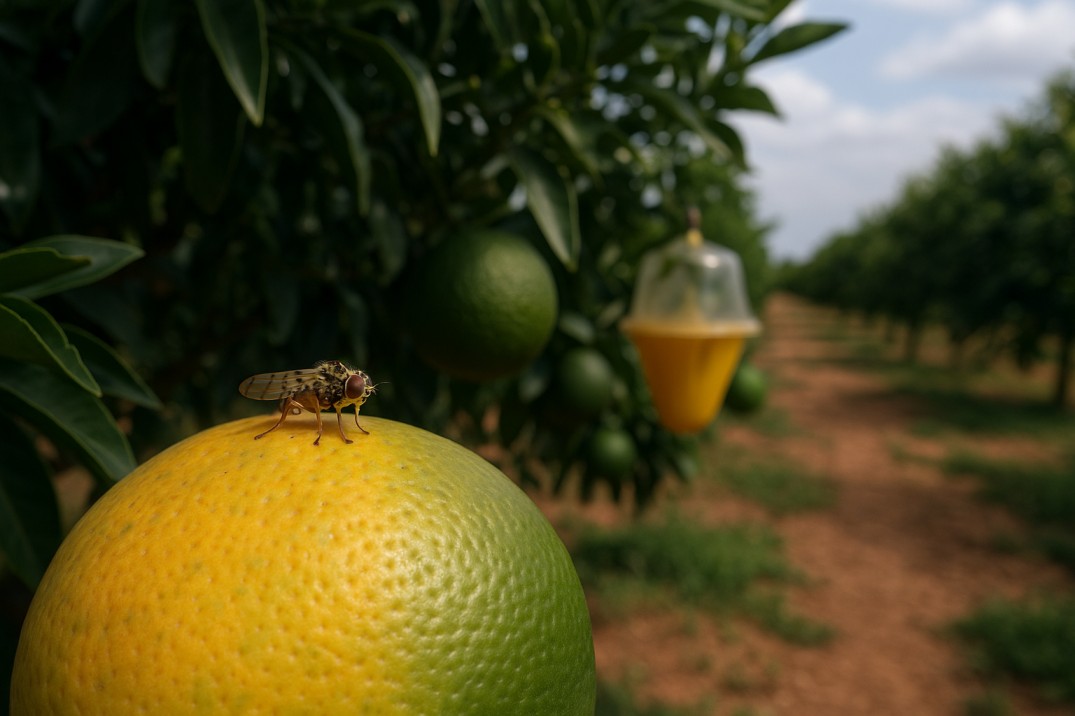Summer and Fruit Flies: 3 Steps to Protect your Citrus
Sep, 2025 • Written by: Carmen Ibarra Galbis

With the arrival of summer, Valencian citrus growers are once again facing one of the most important threats to the quality of their fruit: the fruit fly (Ceratitis capitata). This polyphagous pest (capable of infesting a wide variety of fruits) represents a direct risk to extra-early and early varieties that are now beginning to ripen.
Why should you be concerned? Because the growth of this pest is rapid, silent and, if not acted upon in time, can cause irreversible commercial damage. But with an effective monitoring and control strategy, it is possible to anticipate and protect production.
Early monitoring: The secret of success
Why is it crucial?
During the months of July and August, the combination of temperatures above 25 °C, high humidity, presence of sensitive fruit and untreated areas creates the perfect environment for fruit flies to reproduce at high speed.
Initiating monitoring at this early stage allows:
-
Detect the onset of adult flights.
-
Plan interventions before fruit damage occurs.
-
Reduce population pressure during critical phases of the crop.
How to do it right?
-
Recommended trap type:
Use McPhail or Multilure traps, baited with hydrolyzed protein or area-specific attractants. -
Density of traps:
Place at least one trap per 2 hectares.In sensitive areas, such as orchards with extra-early varieties or historical high pressure locations, it is recommended to increase this density. -
Checking frequency:
The traps should be checked weekly, especially if temperatures exceed 20 °C. This allows constant monitoring of population dynamics. -
Intervention threshold:
Although it may vary according to variety and phenological stage, an accepted indicative threshold is 0.5 captures per trap per day.
Once this threshold is reached (or if there are sustained captures), it is time to act.
Rational treatments: Accuracy, not exaggeration
Controlling fruit flies does not mean applying unplanned treatments. There are three main strategies, each with its own timing and context:
A. Mass trapping: preventive barrier
What are they? Intensively distributed baited traps.
-
Recommended density: between 50 and 80 traps per hectare.
-
Ideal for: small farms, isolated areas or areas with high varietal sensitivity.
-
Advantages: preventive technique, no residues, low environmental impact.
B. Spot spraying: localized efficacy
How are they applied? A mixture of protein bait is prepared with an authorized insecticide such as lambda cyhalothrin, spinosad or deltamethrin.
-
Application: at strategic points (shaded areas), without the need to wet the entire tree crown.
-
Advantages: high efficacy, prolonged protection and minimal effect on auxiliary fauna (pollinators, natural enemies).
This type of treatment is one of the most recommended due to its balance between efficacy and sustainability.
C. Covering treatments: last option
When to use them? Only if flight pressure is high and previous methods have not been sufficient.
-
Key considerations:
-
Use strict technical criteria.
-
Always respect the safety period (SP) of the phytosanitary product before harvesting.
-
Avoid treatments during flowering or presence of pollinators.
-
Abusing this technique can have negative consequences, such as unwanted residues or biological imbalances.
Collective strategy: Without coordination, No control possible
Even if you carry out excellent management on your plot, if neighboring farms do not apply similar measures, flight pressure can remain high and cause re-infestations.
Keys to collaborative management:
-
Detect abandoned or poorly managed areas: these areas quickly become reservoirs for adult flies.
-
Periodic re-injections: if high pressure persists, re-apply baited treatments in defined cycles (every 7-10 days).
-
Talk to your neighbors: organizing synchronized applications in the same area is one of the most effective ways to curb population expansion.
One fly escaping from a poorly managed farm can infest hundreds of fruit on your farm. Don't leave it to chance.
Conclusion
The fight against fruit flies is not won by improvisation, but by constant monitoring, rational treatments and teamwork. This pest does not give truce, but you can get ahead of it.
This summer, don't wait to see stung fruit to act. Set the traps, observe the flights and apply with strategy. Remember: good management today equals a profitable crop tomorrow.
Get ready for CUE 2026
